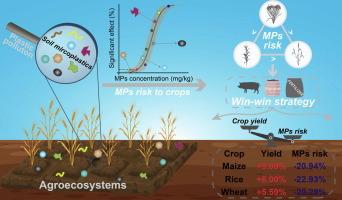基于人工智能的农业生态系统微塑料风险管理策略
IF 11.6
1区 工程技术
Q1 ENGINEERING, MULTIDISCIPLINARY
引用次数: 0
摘要
微塑料污染的持续增加对人类健康和环境可持续性构成重大风险,特别是在农业生态系统中。这项研究的重点是识别和管理中国农业土壤中MP对作物的风险,中国是世界上最大的塑料消费国之一。通过使用3243个站点年的实地观测,我们开发了智能农业模型来预测与mp相关的作物风险,并确定除农用塑料膜使用外的关键驱动因素,如气候、牲畜密度和肥料施用。水稻对MPs最敏感,平均风险商(RQ;单位)为(3.76±1.95),分别是玉米和小麦的2.19倍和1.93倍。气候因素与牲畜密度和农业管理做法密切相关,在未来条件下可能加剧MP风险。优化家畜密度和肥料使用水平可使玉米、水稻和小麦的MP风险分别降低20.9%、22.9%和20.3%,作物产量分别提高9.0%、6.0%和5.6%。尽管存在与模型不确定性和政策实施相关的局限性,但所提出的智能农业模型为评估和管理作物MP风险提供了全面的基础和潜在的解决方案。本文章由计算机程序翻译,如有差异,请以英文原文为准。

AI-Enabled Strategies for Managing Microplastic Risk in Agroecosystems
The continuous increase in microplastic (MP) pollution poses significant risks to human health and environmental sustainability, especially in agroecosystems. This study focused on identifying and managing MP risk to crops in agricultural soils in China, which is among the world’s largest consumers of plastic. Via the use of 3243 site-year field observations, we developed intelligent agriculture models to predict MP-related crop risks and identify key drivers, such as climate, livestock density, and fertilizer application, other than the use of agricultural plastic film. Rice was most sensitive to MPs, with an average risk quotient (RQ; unitless) of (3.76 ± 1.95), which is 2.19 and 1.93 times greater than those of maize and wheat, respectively. Climate factors are closely related to livestock density and agricultural management practices, potentially exacerbating MP risk under future conditions. Optimizing livestock density and fertilizer use levels reduced MP risk by 20.9%, 22.9%, and 20.3% and increased crop yields by 9.0%, 6.0%, and 5.6% for maize, rice, and wheat, respectively. Despite limitations related to model uncertainty and policy implementation, the proposed intelligent agriculture model provides a comprehensive basis and potential solutions for assessing and managing MP risk to crops.
求助全文
通过发布文献求助,成功后即可免费获取论文全文。
去求助
来源期刊

Engineering
Environmental Science-Environmental Engineering
自引率
1.60%
发文量
335
审稿时长
35 days
期刊介绍:
Engineering, an international open-access journal initiated by the Chinese Academy of Engineering (CAE) in 2015, serves as a distinguished platform for disseminating cutting-edge advancements in engineering R&D, sharing major research outputs, and highlighting key achievements worldwide. The journal's objectives encompass reporting progress in engineering science, fostering discussions on hot topics, addressing areas of interest, challenges, and prospects in engineering development, while considering human and environmental well-being and ethics in engineering. It aims to inspire breakthroughs and innovations with profound economic and social significance, propelling them to advanced international standards and transforming them into a new productive force. Ultimately, this endeavor seeks to bring about positive changes globally, benefit humanity, and shape a new future.
 求助内容:
求助内容: 应助结果提醒方式:
应助结果提醒方式:


